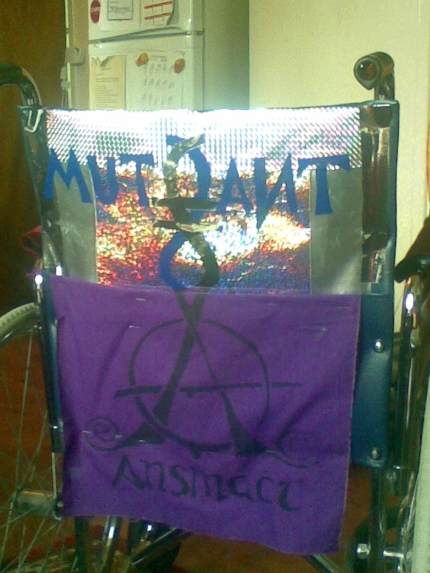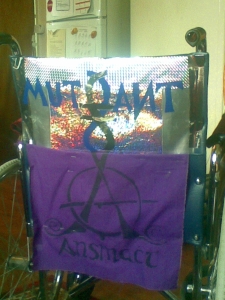She says nothing.
I say nothing.
We both know there are no words
For the misery of women.
from Mamó: A Story of Geraldine Plunkett; ÓBrolcháin Carmody, Isolde (2016)
These are the final lines of my one-woman show, Mamó; A Story of Geraldine Plunkett. It is based on my great-grandmother’s accounts of her family’s involvement in the 1916 Revolution, including the execution of her brother, Joe Plunkett, as the youngest signatory of the Declaration of the Irish Republic.
You probably haven’t heard of my play, and you probably haven’t heard of me. But I’ve been working as an artist for over 20 years. I worked on this play from 2005 to 2016. As the story of a woman’s role in the 1916 Revolution, 2016 made a natural deadline to bring the work to audiences.
I worked with the generous and tireless Donal O’Kelly as director, and together, we devised techniques that would account for my impairments in producing the work. We recorded the script as an audio track because my visual impairment means I couldn’t read a print script. I performed the majority of the show sitting down to account for my chronic pain and fatigue. Finally, we filmed the show to minimise the physical toll that touring and performing would take on my body. All of these choices gave the piece a unique form and aesthetic of which I’m very proud.
I didn’t get to tour the play in 2016 as I had planned. This was largely down to funding: if I had received sufficient funding to tour the play, it would have counted as income according to Social Welfare. It would have counted as “means”, and my basic weekly Blind Pension payment (currently €203 per week), on which I depend to survive, would have been immediately slashed. So even if the tour had been funded, I couldn’t have afforded to pay for anything, let alone a tour. A gal gotta eat!
So without funding, and living below the poverty line on my Blind Pension, I couldn’t afford to tour the show during 2016. I couldn’t afford renting a wheelchair-accessible van plus driver to get me to and from venues. I couldn’t afford the hotels to stay in (B&Bs rarely have accessible bedrooms). I couldn’t afford the research to find theatres with accessible back-stage areas. Besides which, in 2016, I was waiting for a new powerchair, since the old one didn’t work in the rain. And I wasn’t granted extra Personal Assistance hours to help with navigation when my guide dog got too sick to work and then died.
Over the last 18 months (since the first lockdown), I have been sought out and offered money for my arts work like never before. The switch to online living meant that I could work without the constant torture of navigating a world built by non-disabled people. So I decided to register as self-employed with Revenue. For anyone else, it would feel like my career was really taking off, and that my work was being valued.
But, as a disabled artist, this is fraught with dangers. Any earnings over a mere €140 per week (recently upped by a generous €20) start to count against my basic Blind Pension income. And once this income starts reducing, the secondary benefits are immediately put at risk too. I have been on Blind Pension (BP) since I turned 18, and have relied on it, (along with the Free Travel Pass, Medical Card and Household Benefits Package counted as “secondary benefits”), to survive. (Interesting side-note: I am one of only 1,069 people currently on this strangely anachronistic payment, which is overseen by the Old Age Pension office. It’s different to Disability Allowance, for no logical reason I can ascertain).
And while I feel like I’ve been earning money for my creative work lately, here is a list of the things my paid arts work have paid for over the last 18 months:
- New underwear
- Dog food and vet bills (for my guide dog)
- An update to my screen-reading software (the latest release was the first to support hosting Zoom meetings)
- An iPad (the only device with good built-in accessibility)
- One phone bill (my phone is also my internet connection)
- Some toiletries
The screen-reader and iPad are tools without which I can’t work at all. To be honest, I couldn’t actually function day-to-day without them. There is no dedicated funding for assistive technology for the blind, yet we get left further and further behind our non-disabled peers without it.
The rest are the kinds of expenses you might hope would be covered by a basic social welfare payment. But they aren’t. The basic weekly rate is €203. Even if I was earning that magical extra €140 per week, it still doesn’t add up to the €350 per week which was deemed the minimum ammount for PUP when it was introduced. And living with disabilities is expensive! Note, for example, the need to use Apple products as the only devices guaranteed to have a high level of built-in accessibility.
There have been recent changes to the laws governing Disability Allowance (DA), called “Catherine’s Law”, which mean that a disabled student or researcher can take up a scholarship or research grant without it counting against their basic DA rate. There is also a disregard of €50,000 in savings which will not count against DA. The rate for the 1,069 Irish people on Blind Pension is €20,000, and Catherine’s Law has not been extended to those on BP.
There has also been recent coverage of a pilot scheme for guaranteeing a Universal Basic Income (UBI) for artists. It has already been pointed out that this scheme will not benefit the lowest-paid artists as it will impinge on the secondary benefits associated with Job Seekers’ Allowance, such as Rent Allowance payments. This applies equally to disability-related payments.
Catherine’s Law does not benefit disabled artists. UBI does not benefit disabled artists. Getting paid for work does not benefit disabled artists. That is why a group of Disabled Artists and Disabled Academics (DADA) has begun meeting to find a way to change these repressive and discriminatory systems.
However, most disabled artists I have met with to discuss these issues are afraid to publically discuss them. We are afraid that it may trigger a Social Welfare review into our meagre finances. We are afraid that it may brand us as “difficult” with funding bodies. And most of us are keen to spend our energies in our arts practices.
To me, these are screaming alarm-bells of systemic and institutional oppression of a group of people: disabled people. If Ireland is serious about being a signatory to the UN Convention on the Rights of Persons with Disabilities (UNCRPD), the government will undertake an urgent restructuring of how disabled people are supported. In particular, Article 27 of the Convention which guarantees our right to meaningful employment.
Blind Pension and a Free Travel Pass felt like independence at the age of 18. But I’m in my 40s now. The gradual erosion of disability-related benefits and services, especially since 2010, means that I’m living much further below the poverty line now than I was then. And I need to work. I can’t sit around doing nothing. If you are an artist, or live with an artist, you’ll understand why. I will quote my old comrade, Tim Hannon, from a piece called “Why I Write” which we published in our independent school literary magazine, EatMeDrinkMe:
Sometimes I think I confuse the need to eat with the need to write… Why do I write? I write because I’m hungry.
“Why I Write”, Hannon, Tim; EatMeDrinkMe, Dublin, 1994

